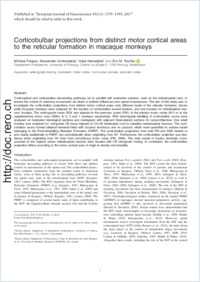Corticobulbar projections from distinct motor cortical areas to the reticular formation in macaque monkeys
- Fregosi, Michela Department of Medecine, University of Fribourg, Switzerland
- Contestabile, Alessandro Department of Medecine, University of Fribourg, Switzerland - Department of Fundamental Neurosciences, University of Geneva, Geneva 4, Switzerland
- Hamadjida, Adjia Department of Neuroscience, Centre de Recherche du Centre Hospitalier de l'Université de Montréal, Montreal (CRCHUM), QC, Canada
- Rouiller, Eric M. Department of Medecine, University of Fribourg, Switzerland
-
01.06.2017
Published in:
- European Journal of Neuroscience. - 2017, vol. 45, no. 11, p. 1379–1395
English
Corticospinal and corticobulbar descending pathways act in parallel with brainstem systems, such as the reticulospinal tract, to ensure the control of voluntary movements via direct or indirect influences onto spinal motoneurons. The aim of this study was to investigate the corticobulbar projections from distinct motor cortical areas onto different nuclei of the reticular formation. Seven adult macaque monkeys were analysed for the location of corticobulbar axonal boutons, and one monkey for reticulospinal neurons' location. The anterograde tracer BDA was injected in the premotor cortex (PM), in the primary motor cortex (M1) or in the supplementary motor area (SMA), in 3, 3 and 1 monkeys respectively. BDA anterograde labelling of corticobulbar axons were analysed on brainstem histological sections and overlapped with adjacent Nissl-stained sections for cytoarchitecture. One adult monkey was analysed for retrograde CB tracer injected in C5-C8 hemispinal cord to visualise reticulospinal neurons. The corticobulbar axons formed bilateral terminal fields with boutons terminaux and en passant, which were quantified in various nuclei belonging to the Ponto-Medullary Reticular Formation (PMRF). The corticobulbar projections from both PM and SMA tended to end mainly ipsilaterally in PMRF, but contralaterally when originating from M1. Furthermore, the corticobulbar projection was less dense when originating from M1 than from non-primary motor areas (PM, SMA). The main nuclei of bouton terminals corresponded to the regions where reticulospinal neurons were located with CB retrograde tracing. In conclusion, the corticobulbar projection differs according to the motor cortical area of origin in density and laterality.
- Faculty
- Faculté des sciences et de médecine
- Department
- Département de Médecine
- Language
-
- English
- Classification
- Biological sciences
- License
-
License undefined
- Identifiers
-
- RERO DOC 305111
- DOI 10.1111/ejn.13576
- Persistent URL
- https://folia.unifr.ch/unifr/documents/306059
Statistics
Document views: 99
File downloads:
- pdf: 352
